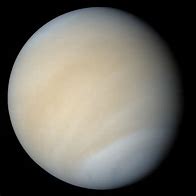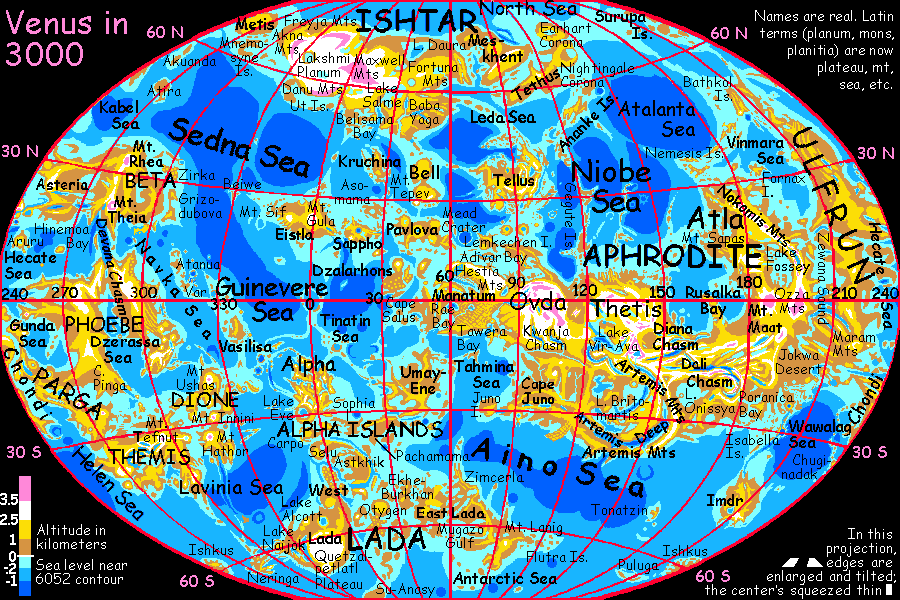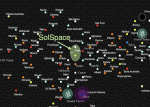You are using an out of date browser. It may not display this or other websites correctly.
You should upgrade or use an alternative browser.
You should upgrade or use an alternative browser.
I made a Galactic Neighbourhood map for space-based games
Thomas Bowman
First Post
I am working on a Solar System map, its not finished yet, it is based on this one:

But mine will be shown from the top down, because that makes it easier to track movement and scale distance. Mine only covers the Solar System out to 200 million miles from the Sun, because the planets I am interested in are Earth 2078 AD, Venus 2078 AD, Legendary Venus, Legendary Earth, and Legendary Mars, each planet has its twin in a parallel universe that includes magic.

This Venus is only of interest because there is an interdimensional gate leading to this Venus:

From Space this Venus looks just like our Venus, it is covered with clouds, except these clouds are lower and thicker and made our of water droplets instead of sulfuric acid, this terraforming project was accomplished using magic from this Venus:

So were talking about four planets here. The goddess Venus creates the wormhole which links the two Venuses, one living the other a dead superheated rock. One can create vast maps, but my map has only a few places of interest, no FTL except perhaps that someday provided by magic, so far its just one Solar System in two universes.

But mine will be shown from the top down, because that makes it easier to track movement and scale distance. Mine only covers the Solar System out to 200 million miles from the Sun, because the planets I am interested in are Earth 2078 AD, Venus 2078 AD, Legendary Venus, Legendary Earth, and Legendary Mars, each planet has its twin in a parallel universe that includes magic.
This Venus is only of interest because there is an interdimensional gate leading to this Venus:
From Space this Venus looks just like our Venus, it is covered with clouds, except these clouds are lower and thicker and made our of water droplets instead of sulfuric acid, this terraforming project was accomplished using magic from this Venus:

So were talking about four planets here. The goddess Venus creates the wormhole which links the two Venuses, one living the other a dead superheated rock. One can create vast maps, but my map has only a few places of interest, no FTL except perhaps that someday provided by magic, so far its just one Solar System in two universes.
Lanefan
Victoria Rules
Now, to add to your fun and make this even more cool:No, that's only 10 parsecs. I've had that for ages - it was done for me by Ian Stead.
I'm adding named stars (only named ones, as that's a manageable amount) to the main map. It's getting quite crowded! Here's a snippet of bit of it.
The universe is in 3 dimensions (that we know of); unfortunately your map and all the other maps really only show two. So, what's needed with each star name is a positive or negative number indicating its "altitude" in parsecs or hexes or light years above or below an arbitrary plane that goes through Sol and parallels the main plane of the Milky Way. Hexes might be easiest for these purposes.
Now, to add to your fun and make this even more cool:
The universe is in 3 dimensions (that we know of); unfortunately your map and all the other maps really only show two. So, what's needed with each star name is a positive or negative number indicating its "altitude" in parsecs or hexes or light years above or below an arbitrary plane that goes through Sol and parallels the main plane of the Milky Way. Hexes might be easiest for these purposes.
I'll leave that particularly onerous task to you! Thanks for volunteering!
I think of this as a sort of 3D version of a Mercator projection. The stars are the correct distance from Earth, but - like on a world map - that results in some spatial distortion.
Thomas Bowman
First Post
If you do a 3-d map, it can only be of a small area if you want to map every star. To give you an idea of what this involves, Here is a map of a small area around our Sun.

This is a map of the stars out to a 5-parsec radius, this includes 53 star systems, this in itself involves a lot of work for the GM if he wants to properly detail each system, the larger the area represented the harder it is to do a 3D map that includes each star. Up until you get to the thickness of the galactic disk, the number of stars in a given area will be approximately proportional the volume of space on your map. If you have around 50 star systems in a 5-parsec radius map, a 10-parsec radius map will have about 400 star systems in it, and if you use a hex map with numbers showing the distance up and down, you soon encounter the problem of some systems being on top of others in you 2D map. For a really large map, the stars are just dots on a map, there are too many to properly detail, so you have to create them on the fly as you player characters visit them.

This is a map of the stars out to a 5-parsec radius, this includes 53 star systems, this in itself involves a lot of work for the GM if he wants to properly detail each system, the larger the area represented the harder it is to do a 3D map that includes each star. Up until you get to the thickness of the galactic disk, the number of stars in a given area will be approximately proportional the volume of space on your map. If you have around 50 star systems in a 5-parsec radius map, a 10-parsec radius map will have about 400 star systems in it, and if you use a hex map with numbers showing the distance up and down, you soon encounter the problem of some systems being on top of others in you 2D map. For a really large map, the stars are just dots on a map, there are too many to properly detail, so you have to create them on the fly as you player characters visit them.
Thomas Bowman
First Post
Makes sense, a large 2D map can have as many stars as a small 3D map. I guess you are looking for distance, because with a 3D map, you get a lot of stars but they tend to be very close, unless you are willing to use a computer to generate an "uncountable" number of worlds for an "uncountable" number of stars. So 5 parsecs = 50 star systems, 10 parsecs = 400 star systems, 20 parsecs = 3200 star systems, which is probably as far as you would want to go. The hardest part would be naming all the worlds you would randomly generate, but you know what, if you throw out the red dwarfs, then your back down to 320 star systems. You could simply have a map which has only the important worlds.
Makes sense, a large 2D map can have as many stars as a small 3D map. I guess you are looking for distance, because with a 3D map, you get a lot of stars but they tend to be very close, unless you are willing to use a computer to generate an "uncountable" number of worlds for an "uncountable" number of stars. So 5 parsecs = 50 star systems, 10 parsecs = 400 star systems, 20 parsecs = 3200 star systems, which is probably as far as you would want to go. The hardest part would be naming all the worlds you would randomly generate, but you know what, if you throw out the red dwarfs, then your back down to 320 star systems. You could simply have a map which has only the important worlds.
That sounds like an entirely different project.
I have no intention of trying to map every star. It's a big scale map showing major galactic features like clusters, nebulas, the Great Rift, etc.
[FONT="]Save[/FONT][FONT="]Save[/FONT]
Last edited:
Thomas Bowman
First Post
That sounds like an entirely different project.
I have no intention of trying to map every star. It's a big scale map showing major galactic features like clusters, nebulas, the Great Rift, etc.[FONT="][B]Save[/B][/FONT][/COLOR][COLOR=#FFFFFF][FONT="]Save[/FONT]
A smaller scale map would have more varied environments. Take for example the Star Wars galaxy. In all the movies of Star Wars you've ever saw, was there ever an occasion for somebody to wear a space suit? Was there ever a planet who's atmosphere was poisonous to humans, and which required special gear to survive on? All Star Wars planets we've ever seen have a few things in common:
1) Breathable Atmospheres
2) Gravity close to that of Earth
3) A day that is more or less the same length as an Earth day.
There is a plausible way to explain this. If you map is the entire galaxy, there are 100 billion stars in our Galaxy, roughly about ten stars for every human living on planet Earth today and then some, if a planet doesn't have the above three properties, it is not on the Galactic Map If the Galaxy is 50,000 light years in radius, and if you made a map that was 100 squares by 100 squares of the Galaxy, Each square would be 1000 light years on a side. Now remember that map I showed you, it was 50 stars within a 5 parsec radius or a 16 light year radius, 1000 light years is 60 times as big with 216000 times the volume and about 10,800,000 star systems. Now If you are going to pick one planet out of 10.8 million, wouldn't you pick one that was pretty close to Earthlike? You wouldn't pick a vacuum world or a world with a poisonous atmosphere, this would be the best world for human habitation out of almost 11 million! It seems that a Galactic Map would feature planets that are all pretty similar to Earth.
Similar Threads
- Replies
- 1
- Views
- 860
- Replies
- 9
- Views
- 6K
- Replies
- 32
- Views
- 11K
- Replies
- 2
- Views
- 5K

